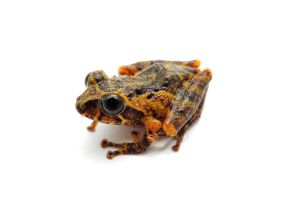
Frogs of Borneo

Frogs of Borneo

Frogs of Borneo

Frogs of Borneo

Frogs of Borneo

Frogs of Borneo

Frogs of Borneo

Frogs of Borneo

Frogs of Borneo

Frogs of Borneo

Frogs of Borneo
Bornean Families
Philautus:
juliandringi
Dring’s Bush Frog
Philautus juliandringi is a rare frog known only from Gunung Mulu National Park, Sarawak. In other words, the species is a Mulu micro-endemic. The type locality is the Pinnacles Trail (04°07′ N, 114°53′ E) on the northern slope of Gunung Api, at approximately 1100 m a.s.l. The species appears to occur only above 700 m. The depicted specimen belongs to a small series later described by Maximilian Dehling from the type locality. Formerly, it had been referred to as P. longicrusby Julian Dring, but Dehling (2010) demonstrated that the Mulu specimens represent a separate species.
This is a small frog (males <20 mm). At first glance, its size, basic coloration, and pattern resemble those of P. refugii (see comments there), but both species clearly differ in head shape and body proportions.
The head is short and wide; the snout is rounded in both profile and dorsal view. The eyes are proportionally large and bulging. Finger and toe tips are expanded into well-developed adhesive discs. The fingers lack webbing, whereas the toes are about half webbed. The species has exceptionally long shanks (tibiae) and slender limbs in general. Calcar spurs are absent. The canthus rostralis is angular and distinct. The tympanum is visible but blends with the surrounding skin. The skin is granular, with scattered low tubercles.
The dorsal coloration is light brown with extensive dark markings in daytime coloration (see image gallery). At night, the dark markings become paler. A dark crossband is present between the eyes, and a large dark marking covers much of the back. Little is known about intraspecific variation. The anterolateral surfaces of the thighs, groin, and flanks are largely unpigmented but bear bright yellow markings. The iris is basically golden but appears brown due to dense dark reticulation.
Specimens are typically found sitting 1.5–2 m above ground on vegetation along the slopes of Gunung Api. Inger et al. (2017) described the call as a “chuckle” of six rapidly repeated notes followed by one or two additional clicks. The reproductive mode of this species, as well as most other aspects of its biology, remains unknown.
Version tracking
-
17.10.2025
updated

